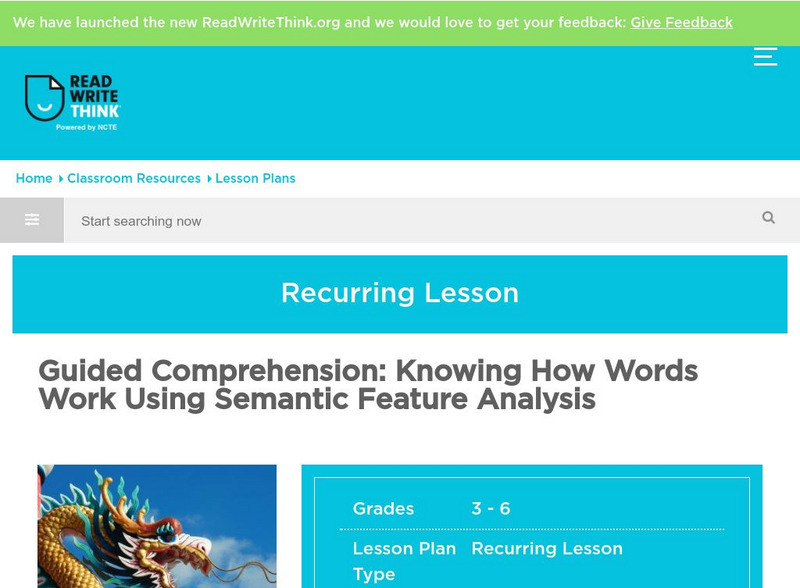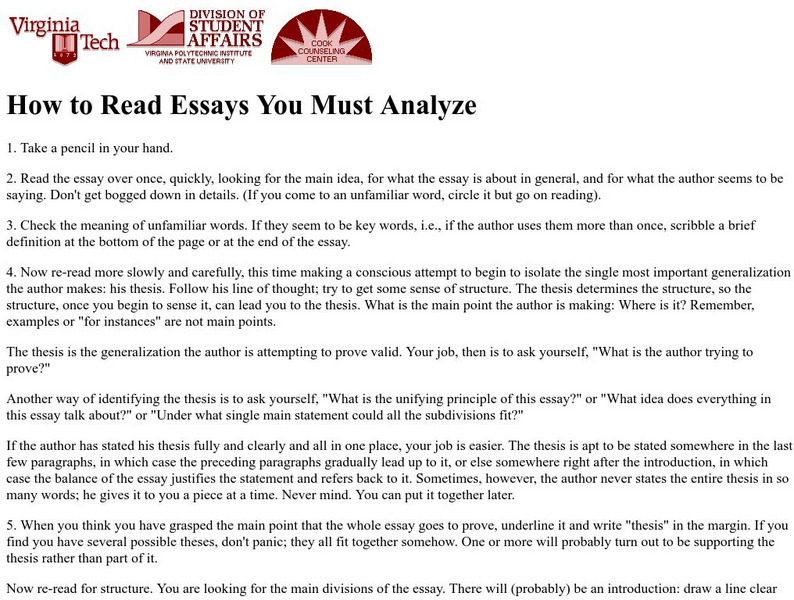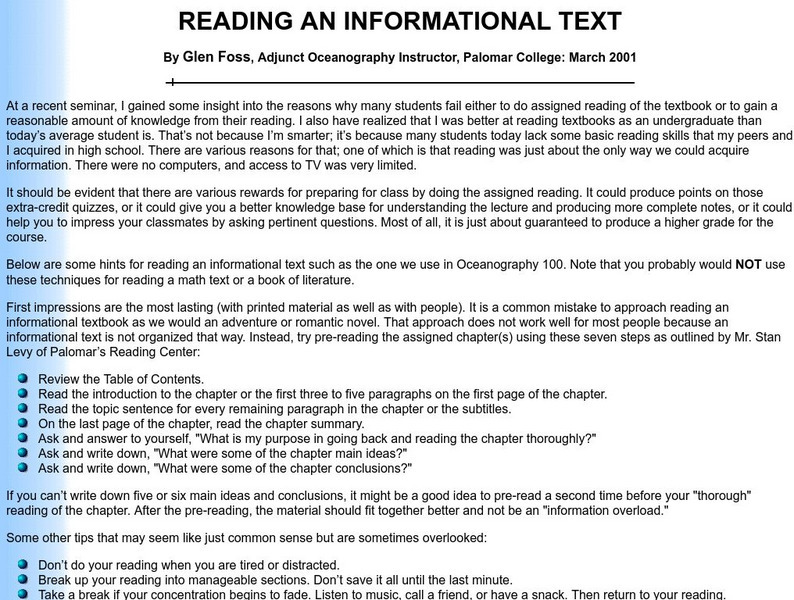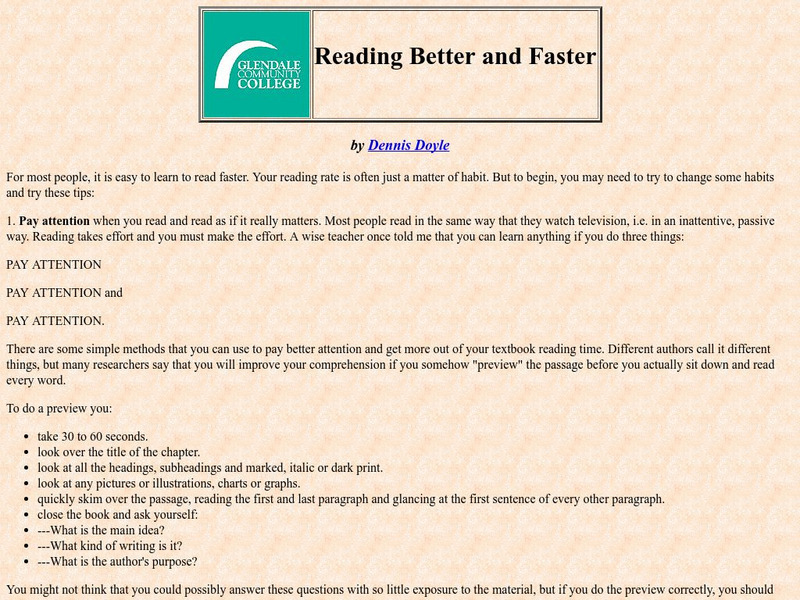ReadWriteThink
Read Write Think: Guided Comprehension: Making Connections
Lesson introduces young scholars to the strategy of making connections. Students learn the three types of connections using a double-entry journal. A good resource for teachers.
ReadWriteThink
Read Write Think: Exploring How Section Headings Support Understanding
Teaching students to pay attention to headings and titles as they read? Here you'll find a practical application for using an expository text to apply the concept of using headings. Geared toward older elementary students, but lesson...
ReadWriteThink
Read Write Think: Guided Comprehension: Semantic Analysis
Lesson introduces learners to comprehension of knowing how words work. Students learn semantic feature analysis and examine folktales, myths, and fables using this analysis to better understand these terms and texts.
ReadWriteThink
Read Write Think: Guided Comprehension: Evaluating
This lesson introduces students to the comprehension strategy of evaluating. Students learn this strategy through the "meeting of the minds" technique that teaches them to act out opposing views of two or more characters.
ReadWriteThink
Read Write Think: Guided Comprehension: Monitoring
Online lesson introduces students to the concept of monitoring. Students learn the INSERT technique, which allows them to monitor their thinking and comprehension using a coding system.
Virginia Tech
How to Read Essays You Must Analyze
Provides a detailed discussion on how to approach an essay for analysis.
International Reading Association
Reading Online: A Survey of Sustained Silent Reading Practices in 7th Grade
Research and ideas about developing a sustained silent reading program in the middle school classroom.
Other
How to Study: A Word Identification Strategy
Learn eight steps to help you identify unfamiliar words.
Palomar Community College District
Palomar College: Reading an Informational Text
Glenn Foss, an instructor at Palomar College, discusses some possible reasons why students have problems reading and recalling textbook material. Provides an outline for seven steps of effectively reading assigned material.
Austin Independent School District
Austin Independent School District: Guided Reading [Pdf]
Learn what guided reading is and how it to use it in the classroom to increase literacy skills. Discover guided reading strategies to use before, during, and after reading. Then follow-up with information on how to create right questions...
Austin Independent School District
Austin Independent School District: A Taxonomy of Literary Genre [Pdf]
A series of graphic organizers shows the progression of learning about literary genre, beginning in kindergarten and building through to fifth grade.
Austin Independent School District
Austin Independent School District: Logical Fallacies [Pdf]
A slide show explaining different types of fallacies in persuasive texts including personal attack, bandwagon, appeal to authority, and many more. Then try to find the fallacy in several examples; answers and explanations provided.
Austin Independent School District
Austin Independent School District: Phonological Awareness Activities [Pdf]
A series of ready-to-print cards filled with ideas and activities to increase students' recognition and understanding of rhyme and rhythm. In Spanish.
Austin Independent School District
Austin Independent School: 10 Major Types of Inference in Literature [Pdf]
This printable worksheet helps students recognize the difference between an implication and an inference. Students are presented with quotes from the text and they practice with each of the ten types of inference: location, agent, time,...
Austin Independent School District
Austin Independent School District: Reading Within Genre [Pdf]
A series of three lesson plans and printable graphic organizers designed to help students find the key traits of the myth, fable, and fairy tale genres.
Other
Live Worksheets: Question Words
This interactive worksheet features interrogative sentences with missing question words. Students will type in one of following words or phrases into each sentence: who, what, where, why, when, how, and more. Students will then submit...
Other
Gcc: Reading Better and Faster
Tutorial site for students that teaches them strategies so they can read faster. This then makes the student a more effective reader.
Other
Phonemic Awareness, Alphabetics and Sight Words
Discover more about phonemic awareness when you visit this informative site. This resource features activities that teach phonemic awareness and activities that teach alphabetics.
ReadWriteThink
Read Write Think: Generating Rhymes for Analogy Based Phonics
This online lesson introduces students to many different approaches toward learning about rhyme and other similarities in words, such as shared/guided reading and small group instruction. A good tool for increasing students' phonological...
ReadWriteThink
Read Write Think: Guided Comprehension: Self Questioning
Online lesson introduces students to the concept of self-questioning, assisting them in an understanding of question-answer relationships that should improve their reading comprehension skills. In-depth study will lead to improved...
Austin Independent School District
Austin Independent School District: Fun With Word Walls [Pdf]
A series of nine activities to use while introducing and practicing with words on word walls. Activities include Funky Cheers, Words Undercover, Magic Words, Finish My Word, Create Complete Sentences, Word Categories, Rhyme Roundup,...
Other
Nsw Dept. Of Ed.: "One World" [Pdf]
Reading unit plan about endangered animals from the New South Wales, Australia, Department of Education and Training entitled "One World" (Forty-four page PDF file). It contains ten days worth of teaching suggestions that use a variety...
Other
Tutorial World: Basic Reading Worksheets for Grade 5
This is a site for teachers looking for worksheets for fifth-grade English students. Includes vocabulary, grammar, sentence construction, comprehension and revision.
Other
Tutorial World: Primary 1 English
This site provides worksheet resources for teachers of grades 1 to 3 on vocabulary, grammar, sentence construction, revision, and comprehension.
















